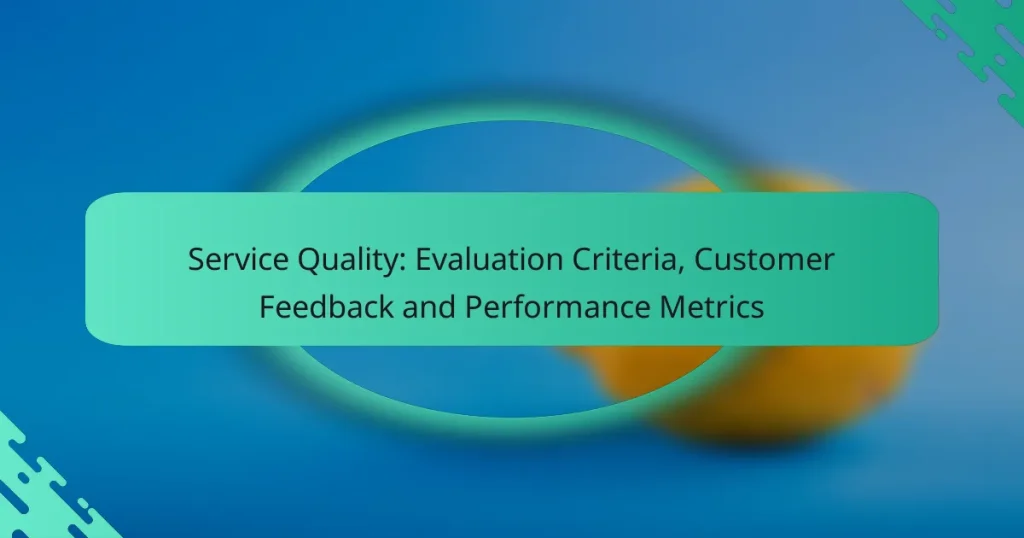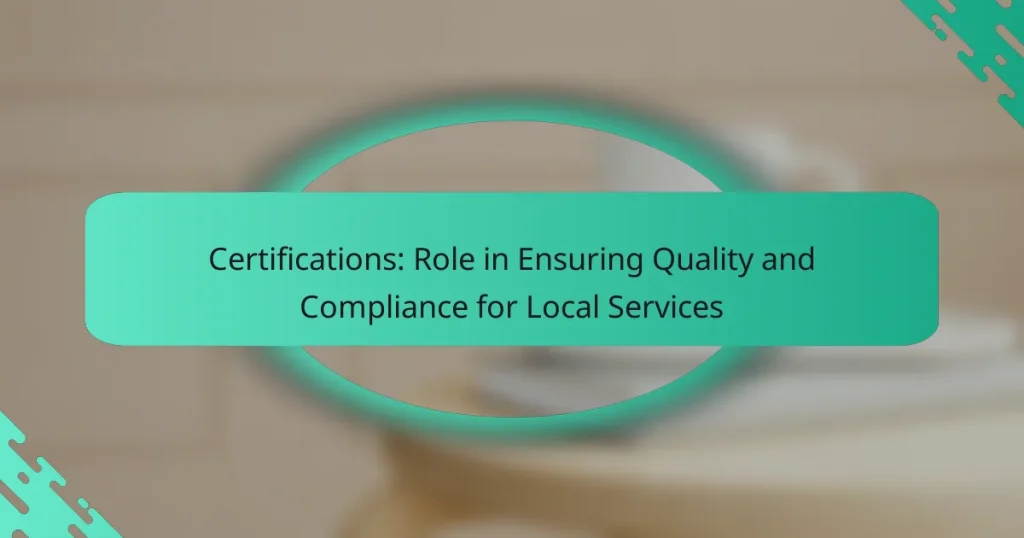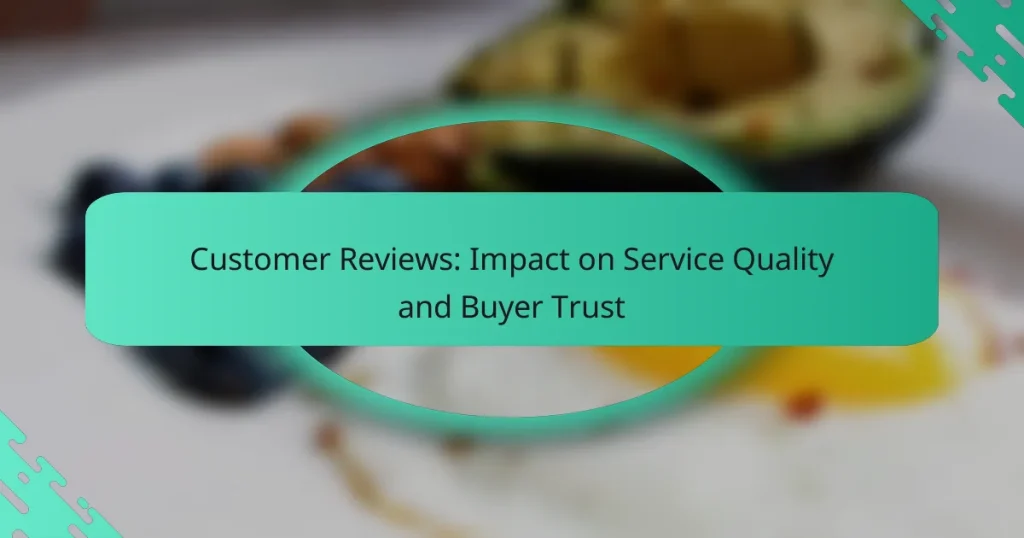When selecting a local service provider, understanding the quality of service they offer is essential. Key factors such as customer feedback, response times, and professional certifications can help gauge their reliability and effectiveness. By focusing on best practices and maintaining strong customer relationships, service providers can enhance satisfaction and ensure long-term success.
Response Time: Importance in Service Quality and Customer Experience
Certifications: Role in Ensuring Quality and Compliance for Local Services
Customer Reviews: Impact on Service Quality and Buyer Trust
How to evaluate local service quality?
To evaluate local service quality, consider customer feedback, service guarantees, response times, and professional certifications. These factors provide insight into the reliability and effectiveness of service providers in your area.
Customer reviews and ratings
Customer reviews and ratings are crucial indicators of service quality. Look for platforms where customers share their experiences, such as Google Reviews, Yelp, or local forums. A high average rating, typically above four stars, often signifies a trustworthy provider.
Pay attention to the volume of reviews as well. A service with numerous positive reviews is generally more reliable than one with only a few. Look for patterns in feedback, such as consistent praise for specific aspects like punctuality or professionalism.
Service guarantees and warranties
Service guarantees and warranties reflect a provider’s confidence in their work. A solid guarantee, such as a satisfaction guarantee or a warranty on parts and labor, can protect you from poor service outcomes. This shows the provider is committed to quality.
When evaluating guarantees, check the terms and duration. A warranty that lasts several months or even years is preferable, as it indicates the provider stands behind their work for an extended period.
Response time and availability
Response time and availability are essential for assessing service quality. A provider that responds quickly, ideally within a few hours, demonstrates good customer service. Availability during evenings or weekends can also be a significant advantage, especially for urgent needs.
Consider asking potential providers about their typical response times and availability for appointments. A reliable service should offer clear communication about when they can assist you.
Professional certifications
Professional certifications can enhance a service provider’s credibility. Certifications from recognized industry organizations indicate that the provider has met specific standards and possesses the necessary skills. For example, HVAC technicians may hold NATE certification, while electricians might be licensed by local authorities.
When evaluating a provider, inquire about their certifications and any ongoing training they undergo. This can help ensure they are up-to-date with the latest industry practices and technologies.
What are the best practices for local service providers?
Best practices for local service providers focus on delivering consistent quality and maintaining strong relationships with customers. These practices enhance service reliability and customer satisfaction, which are crucial for long-term success.
Consistent communication
Consistent communication is vital for local service providers to keep customers informed and engaged. Regular updates about services, schedules, and any changes help build trust and transparency.
Utilize various channels such as emails, text messages, and phone calls to reach customers effectively. Establishing a routine for communication, like weekly updates or monthly newsletters, can keep clients in the loop.
Regular training and updates
Regular training ensures that staff members are equipped with the latest skills and knowledge to provide high-quality service. This can include workshops, online courses, or hands-on training sessions.
Providers should also stay updated on industry trends and regulations. For instance, in the European Union, compliance with GDPR for data protection is essential, and staff should be trained accordingly.
Customer feedback integration
Integrating customer feedback is crucial for improving service quality. Actively seeking input through surveys or direct conversations allows providers to understand client needs and preferences better.
Establish a system for analyzing feedback and implementing changes based on common suggestions. For example, if multiple customers request extended service hours, consider adjusting your schedule to accommodate this demand.
How to choose a reliable local service provider?
Choosing a reliable local service provider involves assessing their reputation, service quality, and customer feedback. Start by researching options in your area and consider factors such as experience, pricing, and availability.
Check local business directories
Local business directories are valuable resources for finding service providers in your area. Websites like Yelp, Angie’s List, or local chamber of commerce listings can give you insights into various businesses, including customer reviews and ratings.
When using these directories, look for providers with high ratings and a significant number of reviews. This can indicate a consistent level of quality and customer satisfaction.
Ask for referrals from neighbors
Referrals from neighbors can lead you to trustworthy local service providers. Speak with friends or family in your community to gather recommendations based on their personal experiences.
When asking for referrals, inquire about specific aspects such as pricing, reliability, and the quality of the work performed. This firsthand information can help you make a more informed decision.
Compare service offerings
Comparing service offerings is crucial to ensure you select a provider that meets your needs. Look at the range of services each provider offers, including any specialties that may be relevant to your situation.
Consider requesting quotes from multiple providers to compare pricing and services. This will help you identify which providers offer the best value for your requirements while ensuring quality and reliability.
What are common service quality metrics?
Common service quality metrics help businesses evaluate their performance and customer satisfaction. These metrics provide insights into how well a service meets customer expectations and can guide improvements.
Net Promoter Score (NPS)
Net Promoter Score (NPS) measures customer loyalty by asking how likely customers are to recommend a service to others. Responses are typically on a scale from 0 to 10, and customers are categorized as promoters, passives, or detractors based on their scores.
A high NPS indicates strong customer loyalty, while a low score suggests areas needing improvement. Businesses should aim for an NPS above 50 to be considered excellent in their industry.
Customer Satisfaction Score (CSAT)
Customer Satisfaction Score (CSAT) gauges how satisfied customers are with a specific service or interaction. This metric is usually collected through surveys immediately after a service experience, asking customers to rate their satisfaction on a scale of 1 to 5 or 1 to 10.
CSAT scores can vary widely by industry, but a score above 80% is generally seen as favorable. Regularly monitoring CSAT can help identify trends and areas for service enhancement.
First Response Time (FRT)
First Response Time (FRT) measures the time it takes for a service provider to respond to a customer inquiry. A shorter FRT is crucial for customer satisfaction, as it reflects the provider’s efficiency and attentiveness.
In many industries, an FRT of under 24 hours is considered acceptable, while top-performing companies often achieve responses within a few hours. To improve FRT, businesses should streamline their communication processes and ensure adequate staffing during peak times.
What are the legal requirements for local service providers?
Local service providers must adhere to various legal requirements to operate legally and effectively. These requirements typically include obtaining necessary business licenses, securing insurance coverage, and complying with local regulations.
Business licenses and permits
Business licenses and permits are essential for local service providers to legally operate within their jurisdiction. The specific licenses required can vary widely depending on the type of service offered and the location. For instance, a plumbing service may need a different license than a landscaping business.
To obtain these licenses, providers often need to submit applications to local government offices, pay associated fees, and meet specific criteria. It’s crucial to check with local authorities to ensure compliance with all licensing requirements to avoid fines or business interruptions.
Insurance coverage
Insurance coverage is a critical legal requirement for local service providers, protecting both the business and its clients. Common types of insurance include general liability, professional liability, and workers’ compensation, depending on the nature of the services offered.
Providers should assess their specific risks and consult with insurance professionals to determine the appropriate coverage levels. In many cases, clients may require proof of insurance before engaging services, making it essential for providers to maintain adequate policies.
Compliance with local regulations
Compliance with local regulations is vital for local service providers to operate without legal issues. These regulations can encompass health and safety standards, environmental laws, and zoning requirements. For example, a construction service must adhere to building codes and safety regulations to ensure the safety of workers and the public.
Providers should regularly review local regulations and stay updated on any changes that may affect their operations. Engaging with local business associations or legal advisors can help ensure ongoing compliance and mitigate risks associated with non-compliance.
How does technology impact service quality?
Technology significantly enhances service quality by streamlining processes and improving customer interactions. Effective use of digital tools can lead to faster response times, better data management, and a more personalized experience for clients.
Use of customer management software
Customer management software (CMS) centralizes client information, enabling service providers to track interactions and preferences. This leads to improved communication and a more tailored service experience. For instance, a local plumbing service can use CMS to remember past issues and suggest preventive measures during follow-ups.
When selecting a CMS, consider features like automation, reporting capabilities, and integration with other tools. A well-chosen system can reduce administrative tasks by up to 30%, allowing staff to focus on customer engagement.
Online booking systems
Online booking systems simplify appointment scheduling for both service providers and clients. These platforms allow customers to view availability and book services at their convenience, reducing no-show rates and optimizing time management for providers.
Look for systems that offer reminders and easy rescheduling options. A good online booking system can increase appointment bookings by 20-40%, making it a valuable investment for local service businesses.



